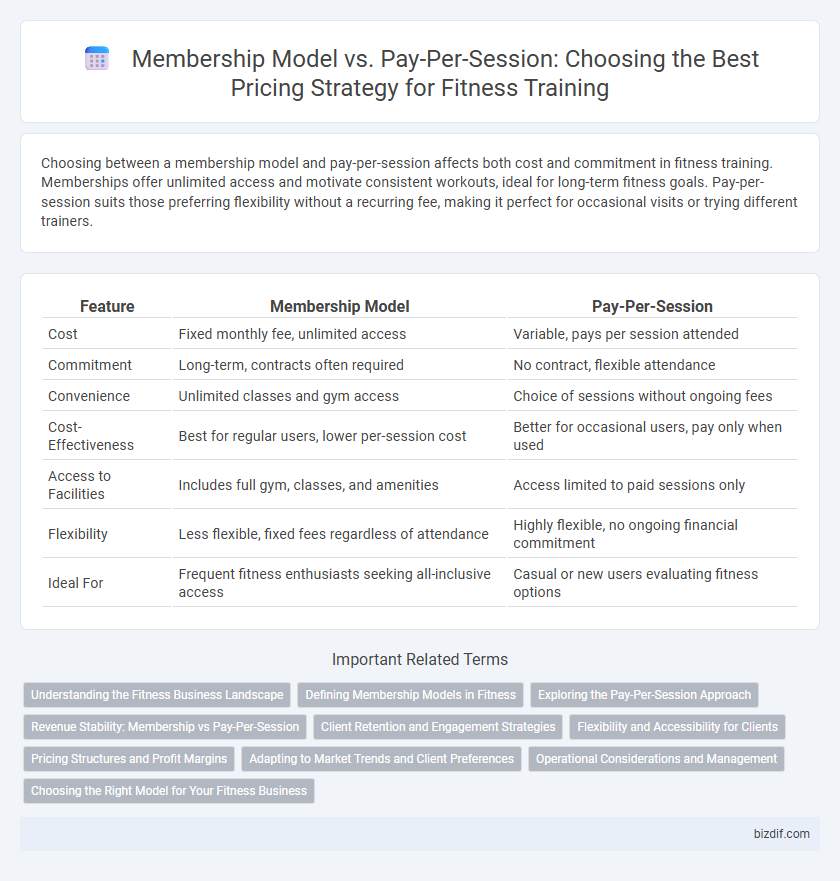Choosing between a membership model and pay-per-session affects both cost and commitment in fitness training. Memberships offer unlimited access and motivate consistent workouts, ideal for long-term fitness goals. Pay-per-session suits those preferring flexibility without a recurring fee, making it perfect for occasional visits or trying different trainers.
Table of Comparison
| Feature | Membership Model | Pay-Per-Session |
|---|---|---|
| Cost | Fixed monthly fee, unlimited access | Variable, pays per session attended |
| Commitment | Long-term, contracts often required | No contract, flexible attendance |
| Convenience | Unlimited classes and gym access | Choice of sessions without ongoing fees |
| Cost-Effectiveness | Best for regular users, lower per-session cost | Better for occasional users, pay only when used |
| Access to Facilities | Includes full gym, classes, and amenities | Access limited to paid sessions only |
| Flexibility | Less flexible, fixed fees regardless of attendance | Highly flexible, no ongoing financial commitment |
| Ideal For | Frequent fitness enthusiasts seeking all-inclusive access | Casual or new users evaluating fitness options |
Understanding the Fitness Business Landscape
A membership model offers consistent revenue by encouraging long-term client commitment, which helps stabilize cash flow and supports sustained gym growth. Pay-per-session pricing attracts occasional users who prefer flexibility but can lead to unpredictable income and higher administrative costs. Fitness businesses must evaluate client behavior and financial goals to determine the optimal pricing strategy within the competitive fitness industry.
Defining Membership Models in Fitness
Membership models in fitness provide unlimited access to classes, facilities, and personal training sessions for a fixed monthly fee, encouraging consistent workout routines and offering better value for regular gym-goers. These models often include tiered options such as basic, premium, and family plans, catering to diverse needs and budgets. By fostering long-term commitment, membership models increase client retention and generate steady revenue streams for fitness centers.
Exploring the Pay-Per-Session Approach
The pay-per-session approach in fitness training offers flexibility by allowing clients to pay only for the workouts they attend, making it ideal for those with irregular schedules. This model helps avoid long-term commitments and upfront fees associated with memberships, attracting users who prefer a budget-friendly, no-obligation fitness routine. Fitness centers adopting pay-per-session can cater to a broader audience seeking personalized training without requiring ongoing financial investment.
Revenue Stability: Membership vs Pay-Per-Session
Membership models generate consistent monthly revenue by locking in clients for a fixed period, enhancing financial predictability for fitness businesses. Pay-per-session relies on sporadic client visits, which can lead to fluctuating income and less reliable cash flow. Stable revenue from membership plans supports better resource planning and growth strategies in the competitive fitness industry.
Client Retention and Engagement Strategies
Membership model in fitness training enhances client retention by fostering a sense of commitment and community, leading to consistent attendance and goal achievement. Pay-per-session offers flexibility but may result in lower long-term engagement due to the lack of ongoing incentive and personalized interaction. Effective client retention strategies include personalized workout plans, regular progress tracking, and community-building activities that encourage consistent participation.
Flexibility and Accessibility for Clients
Fitness training membership models offer enhanced flexibility by providing clients unlimited access to classes and facilities, allowing them to tailor workouts to their schedules and goals. Pay-per-session options increase accessibility for those with irregular availability or budget constraints, enabling clients to pay only for the sessions they attend without long-term commitment. Both models cater to different client preferences, balancing the need for convenience and cost-effectiveness in fitness routines.
Pricing Structures and Profit Margins
Membership models in fitness training offer predictable revenue streams with fixed monthly fees, enabling gyms to optimize profit margins through consistent client engagement and upselling opportunities. Pay-per-session pricing provides flexibility for clients but results in variable income, making profit margins less stable and dependent on fluctuating attendance. Gyms leveraging membership models typically experience higher lifetime client value and reduced administrative costs compared to the pay-per-session approach.
Adapting to Market Trends and Client Preferences
Fitness centers embracing membership models benefit from predictable revenue and foster long-term client engagement, aligning with growing consumer preference for convenience and commitment. Pay-per-session options appeal to clients seeking flexibility and affordability, reflecting a market trend toward personalized fitness experiences and on-demand access. Adapting to these trends, hybrid models combining memberships with pay-per-session offerings optimize client retention and expand market reach.
Operational Considerations and Management
A membership model requires streamlined recurring payment systems and ongoing member engagement strategies to ensure retention and steady revenue flow. In contrast, pay-per-session demands efficient scheduling and real-time resource allocation to manage fluctuating attendance and maximize facility utilization. Operational management must balance staff availability, equipment maintenance, and client service quality differently based on the chosen model to optimize profitability.
Choosing the Right Model for Your Fitness Business
Selecting the right membership model or pay-per-session option depends on your fitness business's target audience, cash flow needs, and marketing strategy. A membership model offers predictable recurring revenue and higher customer retention, ideal for steady growth and community building. Pay-per-session suits clients seeking flexibility and lower commitment, helping attract casual users but requiring more effort in client acquisition and scheduling.
Membership Model vs Pay-Per-Session Infographic

 bizdif.com
bizdif.com